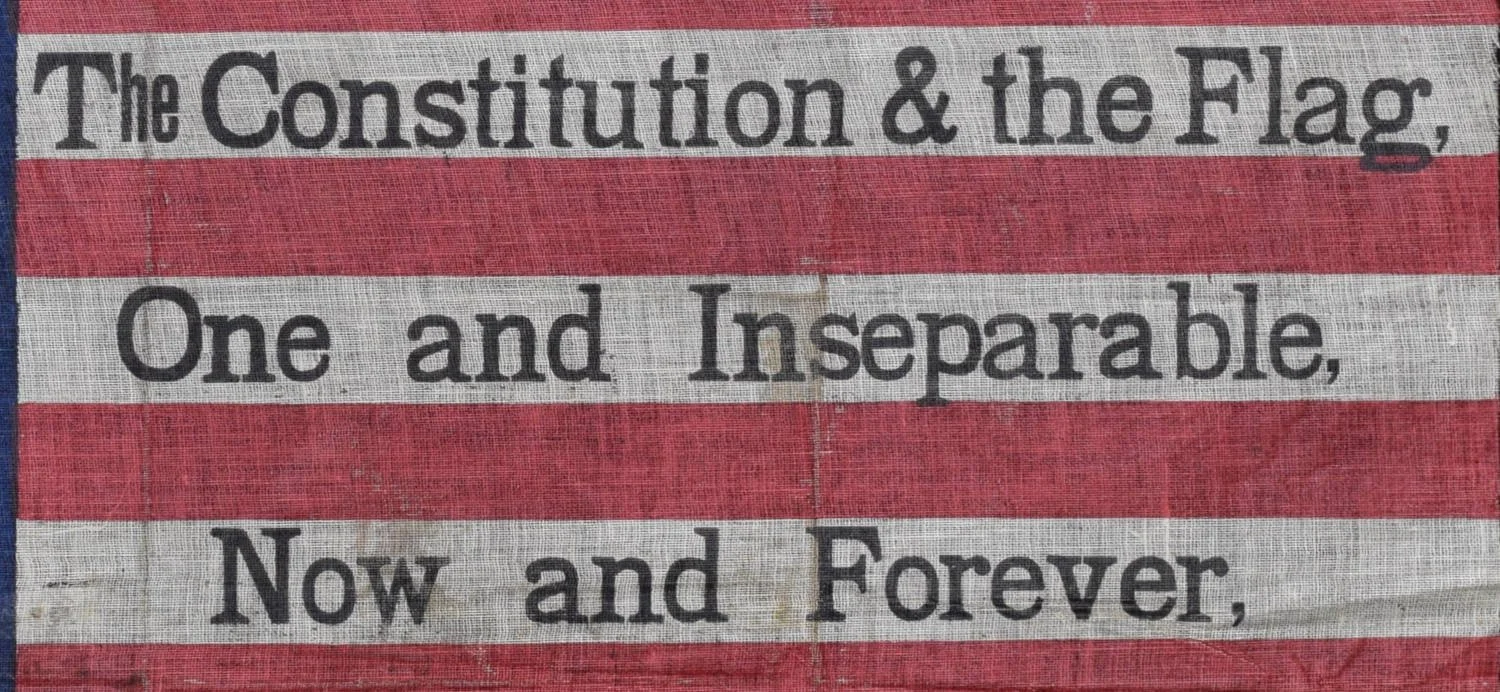Scarce 48 Star Antique Flag with a Wonderful Patriotic Overprint | Arizona Statehood | Circa 1896-1918
Scarce 48 Star Antique Flag with a Wonderful Patriotic Overprint | Arizona Statehood | Circa 1896-1918
Frame Size (H x L): 24.5” x 35”
Flag Size (H x L): 13.5” x 24”
Offered is a forty-eight star parade flag printed on glazed cotton, with the following patriotic overprint:
The Constitution & the Flag,
One and Inseparable,
Now and Forever,
The Flag of the Republic Forever,
Of an Empire Never.
The overprint encapsulates a powerful sentiment that has been central to the American identity for centuries. This expression reflects a commitment to the principles of democracy, freedom, and the unique character of the United States as a republic, rather than an empire
At its core, this phrase emphasizes the interconnectedness of the Constitution and the national flag. The Constitution serves as the foundational legal document that established the framework for the American government, while the flag symbolizes the unity and identity of the nation. The phrase suggests that these two elements are indivisible, underscoring the idea that the principles enshrined in the Constitution are the bedrock upon which the American flag proudly waves.
Following the American Revolution, the Founding Fathers crafted a constitution that aimed to create a government based on the principles of liberty, justice, and the consent of the governed. This Constitution became the cornerstone of the American democratic experiment, and it remains a revered and enduring document to this day.
The flag, on the other hand, has a history that dates back to the nation's founding as well. The Stars and Stripes, as it is commonly known, became the official flag of the United States on June 14, 1777. Each star on the flag represents a state in the Union, while the stripes symbolize the original thirteen colonies. Over time, the flag has evolved and adapted to reflect the growth and diversity of the nation, but its essence as a symbol of unity and freedom has remained constant.
The phrase's assertion that the flag is "of an empire never" is a nod to the United States' rejection of imperial rule. The country was born out of a desire to break free from the yoke of British colonialism and establish a self-governing republic. Throughout its history, the United States has consistently championed the principles of democracy, individual rights, and limited government, distinguishing itself from the colonial empires of the past.
The phrase also carries a sense of permanence and continuity. It declares that the Constitution and the flag are "now and forever." This sentiment reflects the enduring nature of the American experiment in self-governance and the belief that these core principles will continue to guide the nation in perpetuity.
In modern times, this phrase continues to resonate with Americans as a reminder of their unique national identity and the values that bind them together. It reinforces the idea that the United States is not an empire seeking to expand its dominion but a republic dedicated to preserving the rights and freedoms of its citizens.
Furthermore, this phrase has been invoked during times of national crisis and conflict to rally support for the Constitution and the flag. It serves as a unifying call to uphold the principles that define the nation, even in the face of adversity.
THE STAR CONFIGURATION
This flag has a staggered star pattern, in that the rows are laterally offset relative to one another. Early flag makers were free to arrange the stars on a flag’s canton in any manner they liked. This changed, however, on June 24th, 1912, when President Taft issued Executive Order 1556, specifying that the star arrangement on forty-eight star flags should be a rectilinear 8-8-8-8-8-8 pattern. Because flag makers had a great deal of freedom in how they made flags prior to this Executive Order, many forty-eight star flags do not have a linear and horizontal arrangement, particularly those made in the late 19th century and up until the conclusion of WWI. Similar to the star arrangement, the proportions of the US flag were, likewise, not specified until 1912. This flag, for example, is elongated in form compared to modern flags.
FORTY-EIGHT STAR FLAGS
The earliest forty-eight star flags are anticipatory in nature, as flag makers would regularly predict how many states would be added, and when they would be added. By the late 1890s, flag makers began anticipating and offering forty-eight star flags, evidence of which can be found in flag photographs dating to the 1890s, and on flags with dates printed directly thereon.
The forty-eight star flag represents the inclusion of New Mexico and Arizona to the Union. New Mexico was admitted on January 6th, 1912, and Arizona was admitted on February 14th, 1912. The forty-eight star flag became official on July 4th, 1912. Presidents Taft, Wilson, Harding, Coolidge, Hoover, Roosevelt, Truman, and Eisenhower all served under this flag. World Wars I and II, and the Korean War were all fought under it.
The forty-eight star flag was official for forty-seven years up until July 4th, 1959, the time at which the forty-nine star flag became official and began to represent the inclusion of Alaska in the Union.
Conservation Process: This flag was hand sewn to cotton fabric, and both were hand sewn to a mounting board. To prevent the black dye in the cotton fabric from seeping into the flag, it was first washed in a standard wash and then in a dye setting wash. The flag is positioned behind Optium Museum Acrylic.
Frame: This offering is in our X-Large Distressed Black and Silver Frame.
Condition Report: A portion of the white vertical strip and the blue canton is missing. There are stains across the surface. The most notable stains are under the canton, near the white strip. Overall, this flag is very attractive.
Collectability Level: The Great – Perfect for Rising Collectors
Date of Origin: 1896-1918
Number of Stars: 48
Associated War: WWI, WWII, and Korean War
Associated State: Arizona





